|
Recently my friend Lisa invited me to her Boise foothills home for happy hour. I’d not visited in a while, and arrived to find her in the midst of a major backyard renovation. As with many foothills lots, her existing back yard is steeply sloped. Because of this, master plan improvements were focused on earth retention to carve out flat areas for a couple of patios—one off the main living space, and one higher up the slope to take advantage of a downtown view. In the new design, retaining walls and seat walls were constructed of gabion baskets. Though I’ve known about gabions for years, I’d never seen them used like this -- as a featured element in a residential landscape. 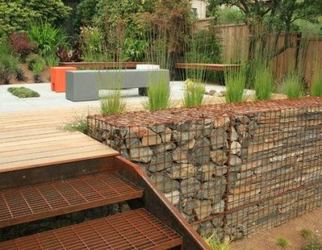 Not Lisa's yard - but a great residential installation. Location unknown. Not Lisa's yard - but a great residential installation. Location unknown. For those who don’t know, gabions (say: GAY’-bee-uns) are a traditional retaining wall system comprised of steel mesh ‘baskets’ filled with rocks. Both the broad footprint and weight of the rocks oppose the overturn force of the earth being retained. Put simply, they’re big and heavy and really effective at holding back slopes. In Lisa’s yard, the designer had employed a gabion wall system to create terraced patios and seating, choosing to leave exposed the steel baskets and the rock within. The visible raw materials created an aesthetic that felt both primitive and modern at the same time. When I admired it, Lisa laughed ruefully and said a number of friends had asked if the walls would eventually be covered with stucco or some other finish. Most had been surprised to hear, “No. They’re just steel cages filled with rocks.” All the same, Lisa clearly loved the effect as much as I did. Gabions are nothing new. They have their roots in engineering, and were in use as early as the Italian Renaissance, where there is mention of Leonardo Da Vinci designing a type of gabion to construct a foundation for the San Marco Castle in Milan. 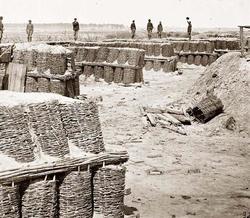 Civil War era use of wicker gabions, Virginia Civil War era use of wicker gabions, Virginia Historically, gabions were sometimes used for military fortifications – as in parapet walls to protect shooting positions – and valued for their lightweight baskets (once woven of wicker), which proved easy to transport and could be filled with materials native to the local area. In the civilian United States, gabions were first commonly used in the early 20th century for engineering purposes such as bridge, dam, roadway, and foundation construction. Other modern applications – in realms hydrologic and ecologic – include stream bank stabilization and the construction of fish ladders. Indeed, they are a tried-and-true engineering tool, but to see such a utilitarian construction method featured front-and-center – in a residential landscape, no less – surprised me. Curious to learn more, I checked in with Chuck Edwards, our chief residential designer at Breckon landdesign, to ask if he had any experience with them. Not surprisingly, he was familiar with gabions and their applications to modern design. In fact, Chuck had recently completed a master plan for a foothills residence (3D Visualization above) that featured gabions as an art element. The sides of the baskets in Chuck’s project were comprised of fine steel mesh that held colored glass in lieu of rock. Even better, the baskets were illuminated from within, to add an unexpected glow of color after dark, and provide a diffuse light source that wouldn’t detract from the foothills view. The gabions featured in this project might have been more expensive than traditional versions, but when it comes to retaining wall systems, gabions are generally less expensive than other kinds of walls. Much of this savings is due to the portability of the baskets, and also their modular nature, which allows them to be installed in flexible configurations without the need for expensive concrete formwork. 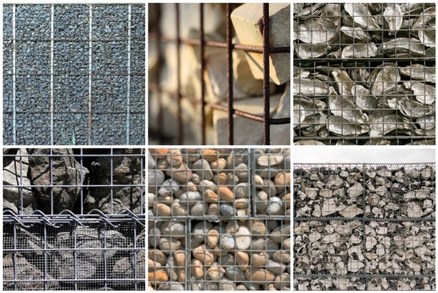 Examples of gabion wall fill, including shells & river cobbles. Examples of gabion wall fill, including shells & river cobbles. As a designer, one thing I love about gabions is that they can be filled with almost any heavy object – when installed in non-structural ways, especially – to complement the theme and aesthetic of your design. Another advantage to gabions is that do-it -yourself-ers can order kits online or find them at local home improvement stores and build their own baskets. Keep in mind that per Idaho building code, any retaining wall over four feet tall must be designed by an engineer. 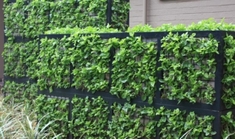 Green wall with gabions Green wall with gabions Gabions do have inherent void space between the "filling" material which tends to fill in over time with sediment, but this additional weight can actually make them more structurally sound. That same void space also provides places for plants to grow, which offers the opportunity to create a green wall, if desired. In reclamation settings, vegetation further aids in stabilization. On the downside, the lifespan of a gabion wall is only as long as the life of the steel basket. These are galvanized for greater durability, but few things last as long as rocks do, after all. Even so, some manufacturers will guarantee the structural integrity of their product (in engineering terms) for up to 50 years.
As a durable, cost-effective construction method gabion walls have more than proven their worth over time. Per their recent appearance in Lisa’s – and various other – modern residential landscapes, gabions also appear to be undergoing a renaissance of sorts. It's always thrilling to see old techniques and materials used in unexpected ways. My re-introduction to gabion walls not only has me on the lookout for other modern installations, but sparks a determination to use them as a design element in future projects. Posted by Kim Warren
3 Comments
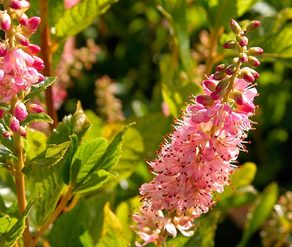 I first learned of this plant from a former colleague of mine who loved to use Summersweet in her planting plans. A gifted designer, she was thrilled to have discovered this small shade-loving shrub that’s not commonly specified and thus more unique than many of the shrubs we typically see in our region. Summersweet is also sometimes referred to as ‘Sweet Pepper Bush’ because the mature fruits --though insignificant and without any element of spiciness -- bear a resemblance to peppercorns. Botanical Name: Clethra alnifolia ‘Ruby Spice’ USDA Hardiness Zone: 4-9 Flower: Fragrant, dark pink bottlebrush-shaped flowers late summer to early fall attract bees and other pollinators. Other cultivars have white or light-pink blooms. Leaves: Small, dark green, with serrate edges --similar in appearance to Alder. A deciduous shrub, yellow fall color extends the season of interest. Sun: Prefers part shade, can tolerate full sun and still produce vivid blooms. Water: Medium to wet conditions; tolerates clay soils. Like most shade-loving plants Summersweet prefers acidic soil. Size/Habit: 3-6’ tall and wide. Attractive when planted as a hedge. 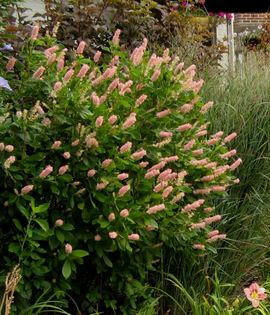 History/Symbolism/Medicine: Clethra is native to the Eastern US, where it can be invasive. The shrub is less vigorous and more manageable in our high desert climate. The genus name comes from the Greek ‘klethra’ (the name for Alder) because the small, serrate leaves have a similar look. This resemblance to alder is reiterated in the species name alnifolia as well. Alnus = Alder; Folia = leaves or foliage. Care/Propagation/Pests: Clethra is trouble-free and relatively low maintenance. To propagate, take greenwood cuttings in early summer. Uses in the Landscape: Because of its shade tolerance, Clethra makes a great understory planting. Roots will sucker under optimal growing conditions (that is, spread out to form a colony of plants), so prune back seasonally unless a naturalized look is desired. This tendency can make Summersweet a great choice for naturalized areas – say a shady berm or stream bank – where erosion control may be needed, or this filling in is otherwise welcome. Posted by Kim Warren When preparing to sell a home, homeowners often hire a staging expert for the interior to showcase their home’s strengths and help it sell more quickly. However, it’s easy to focus so fully on the house itself that the landscape gets overlooked. As a seller, it’s equally important to consider the appeal and livability of the yard, especially because it’s the first thing a prospective buyer encounters. To that end, a few simple, low-cost enhancements can ‘stage’ your home landscape, as well, and result in a more successful sale. According to Amy O’Brien, a realtor for Coldwell Banker Tomlinson Group in Boise, "First impressions are priceless when selling a home. A beautifully landscaped yard that is ready to go makes a property more inviting for a buyer and sets the tone for what to expect inside. As a Realtor I make curb appeal a top priority, as it leads to more showings and a swifter sale at top dollar.” 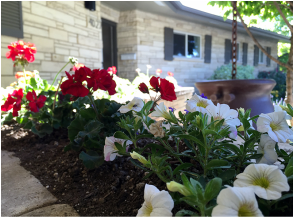 It’s easy to find a wealth of information on curb appeal and easy upgrades to the exterior of your home. In this article, we'll look beyond the possibilities of fresh paint and front door hardware and turn our focus to the landscape. Follow these tips to ensure that your landscape is as worthy of showing as your home: 1. Plan Ahead It’s not always an option, but if you have advance notice of a move, planning ahead can make a huge difference. If selling in the fall, begin working on your landscape in early spring. Planning ahead by a season – even a year or two, if possible –allows time to fix problem areas, especially those that require plant establishment and growth. For example, if there are undesirable views from your property that require screening, taking the time to build a fence or plant a fast-growing hedge can draw buyers’ attention away from potentially negative aspects of your yard or neighborhood. On a shorter time frame, it’s inexpensive and relatively quick to overseed worn or struggling turf areas, or replace them with new sod. Even so, both options require a bit of grow time. 2. Weed and Mulch This is a fairly standard annual task for most homeowners, so do weed and mulch just prior to listing. Immaculate planting beds with a fresh layer of mulch make the yard look tidy and well-maintained, implying the same of the home’s interior. If you use shredded bark, it provides the added benefit of rich color and a wonderful wood scent for buyers approaching your front door. 3. Clean Up and De-clutter Just as you would with your home’s interior, take some time to examine your yard with a critical eye and clear out clutter. To some extent, we cease to really see environments where we spend a lot of time. To work around this common tendency, invite a friend less familiar with your landscape to tour the property and point out areas that may need work. Let them know you expect a firm critique and give them license to be blunt. Offenders might include everything from the remainder of last autumn’s leaves moldering in the beds to gardening tools, toys, or sports equipment that may be lying around. Take a trip to the thrift store to donate unneeded outdoor items. Stash remaining essential gear out of sight in a garage or shed, or arrange neatly in an inconspicuous corner or edge of the yard. 4. Form and Color If you’re selling during the growing season and your yard is light on color and landscape interest, consider brightening up planting beds with annuals and/or plants with unusual foliage or textural appeal. This is an inexpensive, nearly instantaneous way to make dull areas pop. Focus your efforts on the approach to the front door and the entry itself. Glazed ceramic pots planted with combinations of colorful annuals help draw attention to the entry and create a vivid welcome for potential buyers.
A beautiful yard is an asset to any home. While potential buyers are often more focused on the home itself than the yard, the landscape presents an opportunity to create a strong first impression, set the tone for the buyer’s visit, and underscore the value of your house. Spending some extra time to ensure that your landscape is attractive and well-maintained – with a rich variety of sun, shade, and color in welcoming outdoor spaces – can have a significant impact, not only on how fast your home sells, but the ultimate selling price. Posted by Kim Warren |
AuthorsArchives
January 2017
Categories |
Portfolio |
|
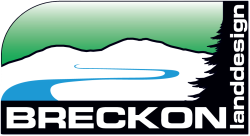
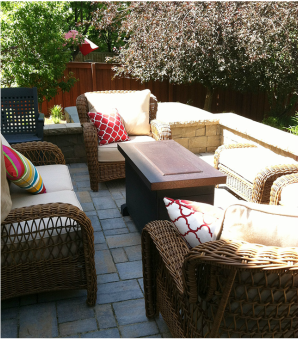
 RSS Feed
RSS Feed
